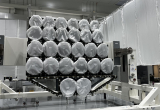As part of its programme, carried out over several years, to study the effects of cosmic rays effects on highly sensitivity cryogenic detectors, the IAS has developed the DRACuLA (Detector irRAdiation Cryogenic faciLity for Astrophysics) system for measuring the response of this type of detector to the impact of particles such as protons or alpha particles.
Latest News
1 year 5 months ago
1 year 5 months ago
Since December 2020, the near-infrared hyperspectral microscope MicrOmega, developed by IAS, took part in the analyzes of the samples returned from the carbonaceous asteroid Ryugu by the JAXA Hayabusa2 mission. Thanks to test campaigns, with IAS participation, this high-performance instrument is now ready to analyze samples from the Bennu asteroid, brought back by OSIRIS-REx.
1 year 5 months ago
The first scientific results from Euclid, the European space cosmology mission, were unveiled on Thursday May 23, 2024: 15 scientific papers, including 5 general ones about the space mission, its instruments and processing, and 10 on the first astrophysical observations. These first observations and articles confirm Euclid's performances, and mark the start of the “Euclid era” for cosmology. The nominal mission will last 6 years, with partial data delivery within 1 year, and the first data delivery within 2 years.
1 year 6 months ago
The Horsehead Nebula has been discovered in the visible range as a dark cloud appearing in extinction at the edge of a giant molecular complex in Orion. It is a photo-dominated region (PDR) illuminated by a massive star. It is of great interest to astrophysicists, as it is the ideal object for understanding the interactions between UV radiation emitted by stars and interstellar matter, the way radiation propagates inside dense clouds, and the impact of radiation on matter (photo-evaporation, ionization, dissociation, fragmentation, heating, etc.).
1 year 8 months ago
How many earth-like planets orbit the habitable zone of solar-like stars? How planets form and evolve in their planetary systems? What about the interaction with their stars? These are among the questions the ESA PLATO mission is called to answer, through exquisite measurements of exoPLAnet Transits and Oscillations of stars (you now know the origin of the PLATO acronym). The “transit” measurements yield information on the size of the planets, while the “stellar oscillations” give us the mass and age of the stars, which in turn are fundamental to assess the mass and age of the hosted planets. The exquisite quality of all such measurements is secured by 26 ultra large field-of-view cameras that make the eyes of the PLATO mission.












